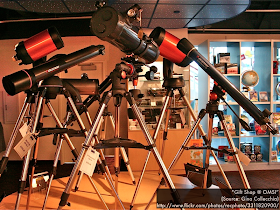Cuesta College, San Luis Obispo, CA
Students have a weekly online reading assignment (hosted by SurveyMonkey.com), where they answer questions based on reading their textbook, material covered in previous lectures, opinion questions, and/or asking (anonymous) questions or making (anonymous) comments. Full credit is given for completing the online reading assignment before next week's lecture, regardless if whether their answers are correct/incorrect. Selected results/questions/comments are addressed by the instructor at the start of the following lecture.
The following questions were asked on reading textbook chapters and previewing presentations on reviewing the history of astronomy, Kepler's and Newton's laws, and telescope powers.

Selected/edited responses are given below.
Describe something you found interesting from the assigned textbook reading or presentation preview, and explain why this was personally interesting for you.
"That eclipses are a result of a the right moon phase and right orbit aligning in a fleeting way."
"Retrograde--it is cool how planets can appear to be moving backwards, because we are passing them in our orbit."
"Tycho, because he wore fake noses to hide a scar in his college days."
"That if your views apposed that of the geocentric universe, you risked being criticized or having charges of heresy brought up or maybe even the death penalty. Astronomy and religion went hand in hand I guess, and it was difficult to separate the two and have beliefs that weren't based on religion. I guess I just kinda feel thankful to be allowed to believe what I want with minimal consequences."
"Newton's cannon to be quite interesting. Just thinking about an object may never touch the ground if fired fast enough because of the effect gravity has."
"That there are colors that the human eye cannot see. For example, infrared light can be felt in some cases as opposed to seen because of its wavelength."
"How the telescopes work--I have wondered since I was eight years old how exactly they operate."
"Connecting multiple telescopes for interferometry. It explained why we have fields of telescopes in proximity to each other."
Describe something you found confusing from the assigned textbook reading or presentation preview, and explain why this was personally confusing for you.
"There is a lot of individual information connected to the astronomers. I felt overwhelmed by the amount of reading."
"I was confused about the ellipses and semi-major axes. Geometry is not my area, so I found it confusing when the book explained it. Maybe a visual example in class might help."
"Kepler's laws and Newton's laws all seemed the same, but I still don't quite know how to distinguish them very well."
"Absorbing all of the different aspects of the telescopes was personally confusing, because all of the terms are kind of similar. It is difficult to separate the terms and match them to their accurate definitions."
"The telescopes are extremely confusing. I'm somewhat confused as to how they work."
When a planet is undergoing retrograde motion, over several nights it moves __________ with respect to the background stars.
east to west. ****************** [18] west to east. ** [2] (Either of the above choices is possible.) * [1] (Unsure/lost/guessing/help!) * [1]
When a planet is undergoing prograde motion, over several nights it moves __________ with respect to the background stars.
east to west. *** [3] west to east. ************* [13] (Either of the above choices is possible.) ** [2] (Unsure/lost/guessing/help!) **** [4]
Categorize each of Kepler's laws.
(Only correct responses shown.)
Kepler's first law: describes the shape of a planet's orbit. [82%]
Kepler's second law: describes the motion of a planet along its orbit. [82%]
Kepler's third law: describes the motion of a planet along its orbit. [55%]
Categorize each of Newton's laws.
(Only correct responses shown.)
Newton's first law: relates forces with changes in motion. [59%]
Newton's second law: relates forces with changes in motion. [73%]
Newton's third law: describes a property of forces. [50%]
The __________ power of a telescope depends on the: (Only correct responses shown.)
light-gathering: diameter of the primary lens/mirror [50%]
resolving: diameter of the primary lens/mirror [68%]
magnifying: both the focal lengths of the primary lens/mirror and eyepiece: [41%]
The least important feature to consider when purchasing an optical telescope is the __________ of its images.
brightness. ** [2] resolution. * [1] magnification. ******************* [19] (Two of the above choices.) [0] (Unsure/lost/guessing/help!) [0]
Briefly explain your answer for the least important feature to consider when purchasing an optical telescope.
"Making an image bigger doesn't make it clearer."
"The magnification is the least important feature, because the size of the image doesn't matter if the resolution isn't clear. You can zoom in on an image, but if the picture has low resolution, then the image will still be blurry no matter the size."
"Magnification just enlarges the image it doesn't help the resolution."
"Magnifying power can be adjusted by the eyepiece, while brightness and resolving power depend of the telescope itself."
"Magnification is the least important because magnifying something does make it bigger but if the resolution of the image is low, then it will be a blurry picture. You need high resolution to make magnification work effectively."
Ask the instructor an anonymous question, or make a comment. Selected questions/comments may be discussed in class.
"Can you go over the telescope and how the different parts work with each other?"
"I think I need some clarification on how light-gathering, resolution, and magnification powers relate to the certain parts of the telescope."
"Could you please explain the directions of retrograde and prograde more? Such as east or west directions. Thanks!"
"Are there places nearby where the public can see the night sky out of telescopes?" (Weather permitting, the Central Coast Astronomical Society has star parties at the Santa Margarita KOA Campground once a month.)
Can I come into office hours and go through the question packet with you and get help with the ones I don't know." (Yes, Tuesday and Thursday afternoons at North County campus.)
No comments:
Post a Comment